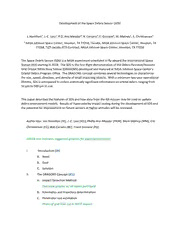
NASA Technical Reports Server (NTRS) 20170001358: Development of the Space Debris Sensor (SDS) Development of the Space Debris Sensor (SDS) Development of the Space Debris Sensor PDF
Preview NASA Technical Reports Server (NTRS) 20170001358: Development of the Space Debris Sensor (SDS) Development of the Space Debris Sensor (SDS) Development of the Space Debris Sensor
Development of the Space Debris Sensor (SDS) J. Hamilton1, J.-C. Liou1, P.D. Anz-Meador2, B. Corsaro3, F. Giovane3, M. Matney1, E. Christiansen1 1 NASA Johnson Space Center, Houston, TX 77058, 2Jacobs, NASA Johnson Space Center, Houston, TX 77058, 3LZT-Jacobs JETS Contract, NASA Johnson Space Center, Houston, TX 77058 The Space Debris Sensor (SDS) is a NASA experiment scheduled to fly aboard the International Space Station (ISS) starting in 2018. The SDS is the first flight demonstration of the Debris Resistive/Acoustic Grid Orbital NASA-Navy Sensor (DRAGONS) developed and matured at NASA Johnson Space Center’s Orbital Debris Program Office. The DRAGONS concept combines several technologies to characterize the size, speed, direction, and density of small impacting objects. With a minimum two-year operational lifetime, SDS is anticipated to collect statistically significant information on orbital debris ranging from 50 µm to 500 µm in size. This paper describes the features of SDS and how data from the ISS mission may be used to update debris environment models. Results of hypervelocity impact testing during the development of SDS and the potential for improvement on future sensors at higher altitudes will be reviewed. Author key: Joe Hamilton (JH), J.-C. Liou (JCL), Phillip Anz-Meador (PAM), Mark Matney (MM), Eric Christiansen (EC), Bob Corsaro (BC), Frank Giovane (FG) GREEN text indicates suggested graphics for paper/presentation I. Introduction (JH) A. Need B. Goal C. Solution II. The DRAGONS Concept (JCL) A. Impact Detection Method Overview graphic w/ all layers portrayed B. Kinematics and trajectory determination C. Penetrator size estimation Photo of grid lines cut in WSTF impact D. Penetrator density estimation III. Space Debris Sensor (SDS) A. SDS description and location aboard ISS, including FoV (PAM) Isometric drawing of SDS/CEPA Location aboard Columbus EPF/SOX MAGIK fish-eye FoV B. Developmental Testing (EC, PAM: short synopsis of HVI testing) i. Impact location determination/accuracy (BC) Representative graphic, predicted vs. actual impact location, w/ error circle/ellipse ii. Trajectory & Velocity/accuracy (BC) iii. Penetrator size/accuracy a. Estimate from grid (FG) Representative graphic of ΔR b. Estimate from acoustic signal (rise time perimeter) (BC) iv. Penetrator density/accuracy (BC, JH) IV. Anticipated Performance On-orbit A. MM discrimination in data (PAM) ORDEM Mollweid plot of OD flux ≥ 100 μm MEM Mollweid ploat of MM flux ≥ 127 μm B. Non-sensor impacts and false alarms (PAM) C. Anticipated number-size distribution over two years (MM) Number-size distribution based on ORDEM 3.0 D. SDS and the ORDEM environment (MM) Representative, existing charts V. SDS Follow-On Sensors and their Motivation (JCL) ORDEM 3.0 flux as a function of size for ISS orbit, HST orbit, and hi/low sun-synch orbits showing expected, higher flux at altitudes above ISS VI. Conclusions (JH) VII. References
